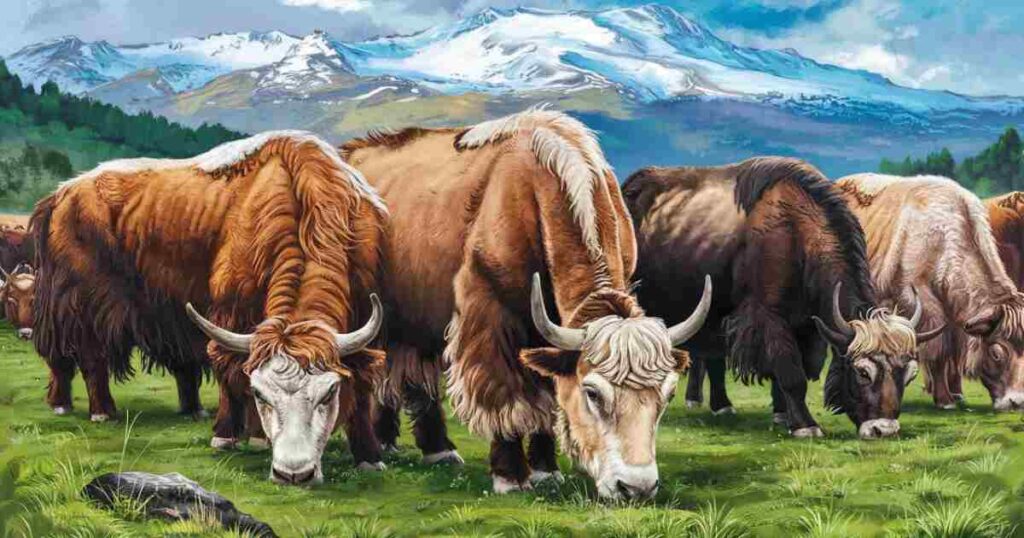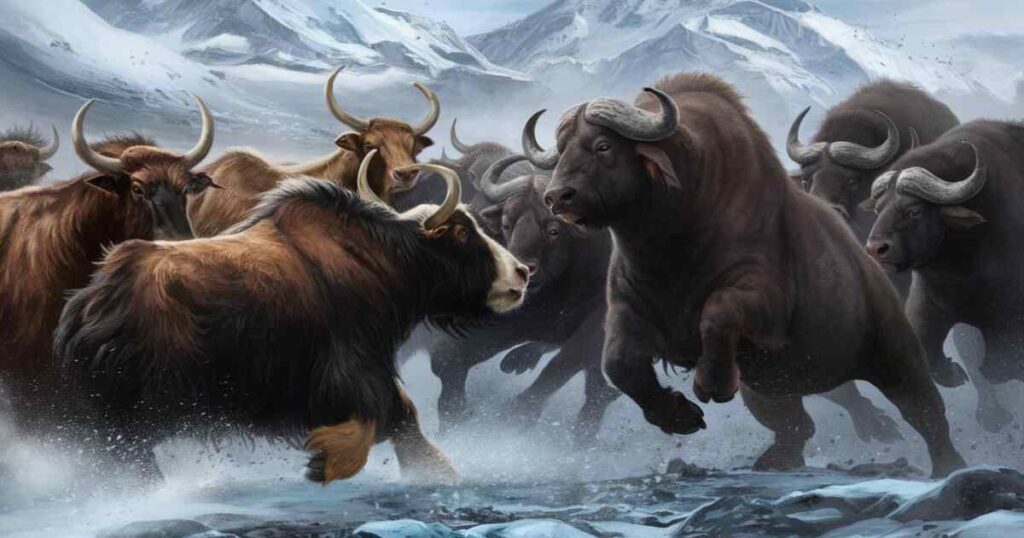When comparing bison, buffalo, and yaks, each has unique traits that set them apart. Bison are native to North America, while buffalo are found in Africa and Asia, and yaks thrive in the high mountains of the Tibetan Plateau. These animals, though related, differ in size, habitat, and physical characteristics.
Bison are known for their large shoulder humps, buffalo for their long curved horns, and yaks for their thick, woolly coats. Despite being part of the Bovidae family, their environments and adaptations make them distinct from one another. Discussing their differences helps us understand these fascinating creatures better.
Understanding Cattle Characteristics
Cattle are diverse in appearance and function, and known for their adaptability to various environments. They typically have a robust build, which helps them thrive in pastures and open fields.
Their coat color can vary widely, including shades from white to brown and black. This variety helps them blend into different habitats and provides some protection against the elements.
Cattle are primarily raised for their utility, including beef, milk, and leather. They are an essential part of agriculture, providing resources that support many aspects of human life.
Bison vs Buffalo vs Yak: Understanding the Differences

Bison, buffalo, and yak are often confused, but they’re distinct animals. All three belong to the Bovidae family, which includes cloven-hoofed, ruminant mammals like cattle and goats. While they share some similarities, they differ in habitat, appearance, and behavior.
Bison are primarily found in North America and parts of Europe, buffalo roam the plains of Africa and Asia, and yaks inhabit the cold, high-altitude regions of Central Asia. Historically, American bison have been mistaken for buffalo, especially in the U.S.
This confusion likely stems from early European settlers who mistook the bison for the African and Asian buffalo they had known. The animals have vastly different physical features and environments, yet the mislabeling persists in popular culture.
Physical Features and Size
One of the most noticeable differences is their size. Bison are known for their large, muscular shoulder humps, which support their heavy heads. Their thick, shaggy coats help them survive cold winters, and they shed these coats in warmer months.
Buffalo, on the other hand, has smoother, thinner coats that don’t change seasonally. They sport longer, curved horns, especially the water buffalo, whose horns can reach up to six feet long. In contrast, bison horns are shorter and more conical.
Yaks, native to Tibet and surrounding areas, also have thick coats to endure freezing temperatures. They’re smaller in size compared to bison but more similar in habitat to the European bison.
All three animals are large, but water buffalo are the heaviest, weighing up to 3,000 pounds. Bison and yaks, while large, generally weigh less, with American bison topping out around 2,200 pounds.
Distinguishing Bison Features

Bison are easily recognized by their large shoulder hump. This muscular feature helps them support their heavy heads, which appear massive compared to their hindquarters. Their thick, shaggy coats offer protection in harsh winters.
In addition to their bulky build, bison have shorter, more conical horns. These horns are much less curved than those of buffalo or yaks. Their dark brown coats shed in warmer months, allowing them to cool off.
Lastly, bison possess a prominent beard, adding to their rugged appearance. This makes them distinct from buffalo, which lack this feature. Overall, bison have a unique look that sets them apart.
- Large shoulder hump for head support
- Thick, shaggy coats that shed seasonally
- Short, conical horns and a prominent beard
Exploring Buffalo Traits
Buffaloes are commonly found in wetlands like swamps and floodplains. Unlike bison, they thrive in hot, humid environments. These habitats influence their physical traits, making them bulkier and heavier.
Their horns are wide, and their faces are broader compared to bison. Buffaloes have sleek, black or dark gray coats, adapted to warm climates. These coats are much thinner than those of bison or yaks.
Another unique trait is their long, tufted tails, unlike the short tails of bison. This feature helps them swat insects in their wetland homes. Each buffalo trait reflects their distinct way of life.
Unraveling the Mysteries of Yaks

Yaks, native to the Tibetan Plateau, are remarkable animals with distinctive features that set them apart from bison and buffalo. These hardy creatures thrive at altitudes ranging from 9,800 to 18,000 feet on the Tibetan Plateau, showcasing their incredible adaptability to high-altitude environments. Their sturdy legs and heavy body make them well-suited for the rugged terrain of their habitat.
Their coat is another fascinating aspect of yaks. Wild yaks typically have a black or dark brown coat, which helps them stay warm in the frigid temperatures of their mountainous home. This dense, shaggy coat is essential for survival in the harsh climate, providing insulation against the cold.
Their robust body type and strength make them invaluable for carrying loads and providing wool, which is used for clothing and shelter in the high-altitude regions they inhabit. Their adaptability and utility highlight their importance in the cultures and economies of the areas they live in.
- Yaks thrive at altitudes between 9,800 and 18,000 feet on the Tibetan Plateau.
- Their heavy body and sturdy legs are adapted to rugged mountainous terrain.
- Wild yaks typically sport a black or dark brown coat for warmth.
Cattle and Bison: Key Differences

When comparing cattle and bison, the differences become quite clear. Bison, which are native to North and South America, tend to have a distinct physical appearance with a robust and heavy build.
They stand between 5 feet 9 inches and 6 feet 7 inches tall and can weigh between 700 and 2,180 pounds. Their coats are typically brown or black, adapting well to various environments like grasslands and forests.
On the other hand, cattle come in a wide range of sizes and colors, reflecting their diverse breeds and uses. They are generally found in pastures and open fields and their height and weight vary significantly based on the breed. Unlike bison, cattle do not have a specific color or size range and can adapt to various farming environments.
Here’s a simple table to highlight the key differences:
| Feature | Bison | Cattle |
| Average Height | 5ft 9in – 6ft 7in | Variable |
| Average Weight | 700 – 2180 pounds | Variable |
| Coat Color | Brown or Black | Variable |
| Habitat | Grasslands and Forests | Pastures and Open Fields |
Yaks vs. Buffaloes

Yaks and buffaloes, while both part of the Bovidae family, differ significantly in their habitats and physical characteristics. Yaks thrive in the cold, rugged terrains of the Tibetan Plateau, where their thick, shaggy coats help them withstand freezing temperatures.
In contrast, buffaloes are found in the warmer wetlands and forests of Africa and Asia, where their lighter coats are adapted to humid environments.
When comparing their size and build, yaks are generally stockier and more robust, suited for high-altitude living with sturdy legs and a heavy body. Buffaloes, on the other hand, are bulkier and heavier, with a more massive build to navigate their swampy and forested habitats.
Each species is uniquely adapted to its environment, showcasing the diverse adaptations within the Bovidae family.
Differences Between Yaks and Buffaloes
| Feature | Yaks | Buffaloes |
| Habitat | Tibetan Plateau, cold high-altitudes | Swamps, forests, and floodplains |
| Coat | Thick, shaggy, black or brown | Thinner, dark gray or black |
| Body Type | Heavy body, sturdy legs | Bulkier, larger build |
| Size | Average 6ft 7in, up to 2600 pounds | Average up to 1200 kg, size varies |
Conservation Efforts for These Four Species
Conservation efforts for bison focus on restoring their populations in North America. After near death due to overhunting, programs have reintroduced bison to protected areas and managed herds. These efforts aim to increase their numbers and preserve their natural habitats.
Buffalo conservation mainly targets African Cape buffalo and Asian water buffalo. In Africa, protected reserves help safeguard Cape buffalo from poaching and habitat loss. For Asian water buffalo, conservation includes protecting wild populations and managing domesticated herds to prevent their decline.
Yaks also face conservation challenges, especially in the Himalayas and Tibetan Plateau. Efforts here involve protecting their natural habitat from overgrazing and climate change. Additionally, local communities are encouraged to maintain traditional practices that support yak populations and their ecosystems.
Bison Vs Buffalo Vs Yak
| Feature | Bison | Buffalo | Yak |
| Habitat | North & South America, Europe | Africa (Cape), Asia (Water Buffalo) | Tibetan Plateau, Himalayas |
| Average Weight | 700 – 2,200 pounds | 1,500 – 2,600 pounds | 660 – 2,200 pounds |
| Coat | Thick, shaggy, brown or black | Short, thin, dark gray or black | Thick, long, black or brown |
| Horn Shape | Short, curved | Long, curved outward | Long, curved upward |
| Size | Up to 6 feet tall | Up to 6.7 feet tall | 5 to 6.5 feet tall |
| Use | Meat, conservation | Work, milk, meat | Work, milk, transport |
| Environment | Grasslands, forests | Swamps, forests, floodplains | Cold, mountainous regions |
Can Yalk Breed With Bison?
Yaks can breed with bison, creating hybrid offspring with unique traits. While female yak-bison hybrids are fertile, the males are typically sterile. This is similar to how yaks interbreed with cattle, where only female hybrids can reproduce.
The resulting yak-bison hybrids are known for their impressive stamina and speed. These hybrids, however, are rare due to the reproductive challenges, especially with male fertility. Despite this, their combination offers fascinating insights into crossbreeding within the Bovidae family.
Frequently Asked Questions
Is a yak a bison or buffalo?
No, a yak is neither a bison nor a buffalo. It belongs to a different species within the Bovidae family, mainly found in high-altitude regions like the Tibetan Plateau.
Why is bison not called buffalo?
Bison are often mistakenly called buffalo due to early European explorers confusing them with true buffalo, which are native to Africa and Asia.
Is there a difference between a bison and a buffalo?
Yes, bison live in North America and Europe, while buffaloes are found in Africa and Asia. They differ in size, habitat, and physical traits like horns and coat.
Can yaks breed with bison?
Yes, yaks can breed with bison. The female hybrids are fertile, but male hybrids are usually sterile.
Can bison produce milk?
Yes, bison can produce milk, but it is not commonly harvested for consumption like cow’s milk.
What habitats do bison live in?
Bison prefer grasslands and forests, especially in North and South America.
Do buffalo have bigger horns than bison?
Yes, buffalo, especially African ones, have larger, curved horns compared to the shorter, straighter horns of bison.
What are yaks primarily used for?
Yaks are mainly used for milk, meat, and as pack animals in high-altitude regions like the Himalayas.
Conclusion
Bison, buffalo, yaks, and cattle each play a unique role within the Bovidae family, offering distinct characteristics and contributions to their environments. From the rugged strength of bison and yaks to the adaptability of buffalo and cattle, these animals highlight the incredible diversity found in nature.
Understanding their traits not only deepens our appreciation for these species but also emphasizes the importance of conservation efforts to protect their habitats and ensure their survival for future generations.
Also Read:

